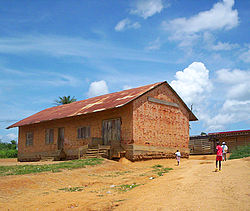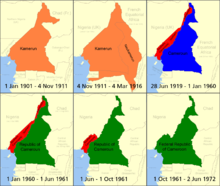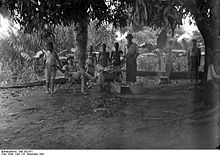History of Cameroon - Picture
More about World War 1

|
|
History of Cameroon

Picture - German-built building at Ambam, today used as a school
This article documents the history of Cameroon.
Early history
The earliest inhabitants of Cameroon were probably the Baka (Pygmies). They still inhabit the forests of the south and east provinces. Bantu speakers originating in the Cameroonian highlands were among the first groups to move out before other invaders. The Mandara kingdom in the Mandara Mountains was founded around 1500 and erected magnificent fortified structures, the purpose and exact history of which are still unresolved. The Aro Confederacy of Nigeria may have had presence in western (later called British) Cameroon due to migration in the 18th and 19th centuries.
During the late 1770s and the early 19th century, the Fulani, a pastoral Islamic people of the western Sahel, conquered most of what is now northern Cameroon, subjugating or displacing its largely non-Muslim inhabitants.
Although the Portuguese arrived on Cameroon's doorstep in the 16th century, malaria prevented significant European settlement and conquest of the interior until the late 1870s, when large supplies of the malaria suppressant, quinine, became available. The early European presence in Cameroon was primarily devoted to coastal trade and the acquisition of slaves. The northern part of Cameroon was an important part of the Muslim slave trade network. The slave trade was largely suppressed by the mid-19th century. Christian missions established a presence in the late 19th century and continue to play a role in Cameroonian life.
Colonization

Picture - Cameroon over time, German Kamerun, British Cameroons, French Cameroun, Republic of Cameroon

Picture - German Settlers celebrating Christmas in Kamerun
Further information: German Kamerun, French Cameroun, British Cameroons
Beginning on July 5, 1884, all of present-day Cameroon and parts of several of its neighbours became a German colony, Kamerun, with a capital first at Buea and later at Yaoundé.
The Imperial German government made substantial investments in the infrastructure of Cameroon, including the extensive railways, such as the 160-metre single-span railway bridge on the Sanaga South branch. Hospitals were opened all over the colony, including two major hospitals at Douala, one of which specialised in tropical diseases (the Germans had discovered the 1912, wrote in an official report in 1919 that the population of Kamerun had increased significantly. However, the indigenous peoples proved reluctant to work on these projects, so the Germans instigated a harsh and unpopular system of forced labour. In fact, Jesko von Puttkamer was relieved of duty as governor of the colony due to his untoward actions toward the native Cameroonians. In 1911 at the Treaty of Fez after the Agadir Crisis, France ceded a nearly 300,000 km² portion of the territory of French Equatorial Africa to Kamerun which became Neukamerun, while Germany ceded a smaller area in the north in present day Chad to France.
In World War I the British invaded Cameroon from Nigeria in 1914 in the West Africa campaign, with the last German fort in the country surrendering in February 1916. After the war this colony was partitioned between the United Kingdom and France under a June 28, 1919 League of Nations mandates (Class B). France gained the larger geographical share, transferred Neukamerun back to neighboring French colonies, and ruled the rest from Yaoundé as Cameroun (French Cameroons). Britain's territory, a strip bordering Nigeria from the sea to Lake Chad, with an equal population was ruled from Lagos as Cameroons (British Cameroons). German administrators were allowed to once again run the plantations of the southwestern coastal area. A British Parliamentary Publication, Report on the British Sphere of the Cameroons (May 1922, p. 62-8), reports that the German plantations there were "as a whole . . . wonderful examples of industry, based on solid scientific knowledge. The natives have been taught discipline and have come to realise what can be achieved by industry. Large numbers who return to their villages take up cocoa or other cultivation on their own account, thus increasing the general prosperity of the country."
In 1955, the outlawed Union of the Peoples of Cameroon (UPC), based largely among the Bamileke and Bassa ethnic groups, began an armed struggle for independence in French Cameroon. This rebellion continued, with diminishing intensity, even after independence. Estimates of death from this conflict vary from thousands to hundreds of thousands.
Cameroon after independence
French Cameroons achieved independence on January 1, 1960 as the Republic of Cameroon. After Guinea, it was the second of France's colonies in Sub-Saharan Africa to be granted independence. The following year, on October 1, 1961, the largely Muslim northern two-thirds of British Cameroons voted to join Nigeria; the largely Christian southern third, Southern Cameroons, voted to join with the Republic of Cameroon to form the Federal Republic of Cameroon. The formerly French and British regions each maintained substantial autonomy. Ahmadou Ahidjo, a French-educated Fulani, was chosen president of the federation in 1961. Ahidjo, relying on a pervasive internal security apparatus, outlawed all political parties but his own in 1966. He successfully suppressed the continuing UPC rebellion, capturing the last important rebel leader in 1970. In 1972, a new constitution replaced the federation with a unitary state called the United Republic of Cameroon.
Although Ahidjo's rule was characterised as authoritarian, he was seen as noticeably lacking in charisma in comparison to many post-colonial African leaders. He didn't follow the anti-western policies pursued by many of these leaders, which helped Cameroon achieve a degree of comparative political stability and economic growth.
Ahidjo resigned as president in 1982 and was constitutionally succeeded by his Prime Minister, Paul Biya, a career official from the Beti-Pahuin ethnic group. Ahidjo later regretted his choice of successors, but his supporters failed to overthrow Biya in a 1984 coup. Biya won single-candidate elections in 1983 and 1984 when the country was again named the Republic of Cameroon. Biya has remained in power, winning flawed multiparty elections in 1992, 1997, and 2004. His Cameroon People's Democratic Movement (CPDM) party holds a sizeable majority in the legislature.
On August 15, 1984, Lake Monoun exploded in a limnic eruption that released carbon dioxide, suffocating 37 people to death. On August 21, 1986, another limnic eruption at Lake Nyos killed as many as 1,800 people and 3,500 livestock. The two disasters are the only recorded instances of limnic eruptions.
Corruption in Cameroon
Despite democratic reform begun in 1990 with the legalization of political parties other than the CPDM, political power remains firmly in the hands of President Biya and a small circle of CPDM members from his own ethnic group. Biya was reelected on October 11, 1992 amid accusations of voting irregularities. Biya reportedly got 39 percent of the vote to 35 percent for John Fru Ndi. (Ndi briefly proclaimed himself president before the government released the polling figures.) In contrast, the March 1, 1992 legislative election was considered free and fair by international observers, although many parties boycotted the elections and the CPDM won several constituencies by default. But even though opposition parties were well-represented in the legislature (92 of 180 seats), there were, according to the 1992 constitution, few legislative or judicial checks on the president.
Following the elections, civil unrest erupted as the population expressed the widespread belief that Ndi had won the presidential elections. By late 1992, Ndi and his supporters were under house arrest and the international community had made clear its displeasure at the antidemocratic and increasingly violent turn the Biya regime was taking.
Biya agreed in May 1993 to hold a so-called Great National Constitutional Debate and in June he began preparing a draft of a new constitution to be adopted either by referendum or by the National Assembly. In 1994, 16 opposition parties formed a loose alliance, dominated by Ndi's Social Democrats, to work for constitutional and electoral reform. In October 1995, the CPDM reelected Biya as its leader. In December of that year the National Assembly adopted a number of amendments to address the power of the president. These reforms included a strengthening of the judiciary, the creation of a partially elected 100-member senate, the creation of regional councils, and the fixing of the presidential term to 7 years, renewable once. Strikes and demonstrations became commonplace as Biya resisted implementation of reforms.
The May 1997 legislative elections were marred by mismanagement, vote-rigging, and fraud, resulting in the Supreme Court's cancellation of results in three constituencies (seven seats). Based on the misconduct of these elections, the opposition boycotted the October 1997 presidential elections, in which Biya claimed victory with 93 percent of the vote. To add further insult, Cameroon topped Transparency International's list of the most corrupt countries in the world in 1998, prompting the creation of an anticorruption body.
On June 30, 2002 the country held legislative and municipal elections that again were denounced by the opposition as fraudulent. The Supreme Court cancelled the results of nine constituencies, ordering new elections in these constituencies on September 15. In the end, the Cameroon People's Democratic Movement (CPDM)/Rassemblement Démocratique du Peuple Camerounais (RDPC) won 149 of 180 seats.
The victory for the ruling party was cemented with the reelection of the 72-year old president Paul Biya in October 2004, thus enhancing the chances of continued domination by the ruling party until the end of his term in 2011. By 2006, appeals were being heard in Biya's home province in favour of a constitutional amendment that would allow him to run for another term when his current term expires. However, against the backdrop of worsening social conditions and high poverty, students protested and conducted strikes for several weeks in April 2005, and clashes with police led to two student deaths. Opposition parties registered their intention to block any attempt to amend the constitution that would allow Biya to run for a third term.
In early 2006 a final resolution to the dispute between Cameroon and Nigeria over the oil-rich Bakassi peninsula was expected. In October 2002, the International Court of Justice had ruled in favour of Cameroon. Nonetheless, a lasting solution would require agreement by both countries’ presidents, parliaments, and by the United Nations. The peninsula was the site of fighting between the two countries in 1994 and again in June 2005, which led to the death of a Cameroonian soldier.
Football
Cameroon has received some international attention following the relative success of its football team. It has qualified for the FIFA World Cup on a number of occasions. Its most notable performance was at Italia 90, when the team beat Argentina, the then reigning Champions in the opening game; Cameroon eventually lost in extra time in the Quarter Finals to England.
Prominent footballers from Cameroon include:
Roger Milla
Samuel Eto'o
Rigobert Song
Thomas Nkono
Background Note: Cameroon from the U.S. Department of State.
Bullock, A. L. C. (1939). Germany's Colonial Demands, Oxford University Press.
DeLancey, Mark W., and DeLancey, Mark Dike (2000): Historical Dictionary of the Republic of Cameroon (3rd ed.). Lanham, Maryland: The Scarecrow Press.
Schnee, Heinrich (1926). German Colonization, Past and Future: The Truth about the German Colonies. London: George Allen & Unwin.
More aircraft.
Source: WikiPedia